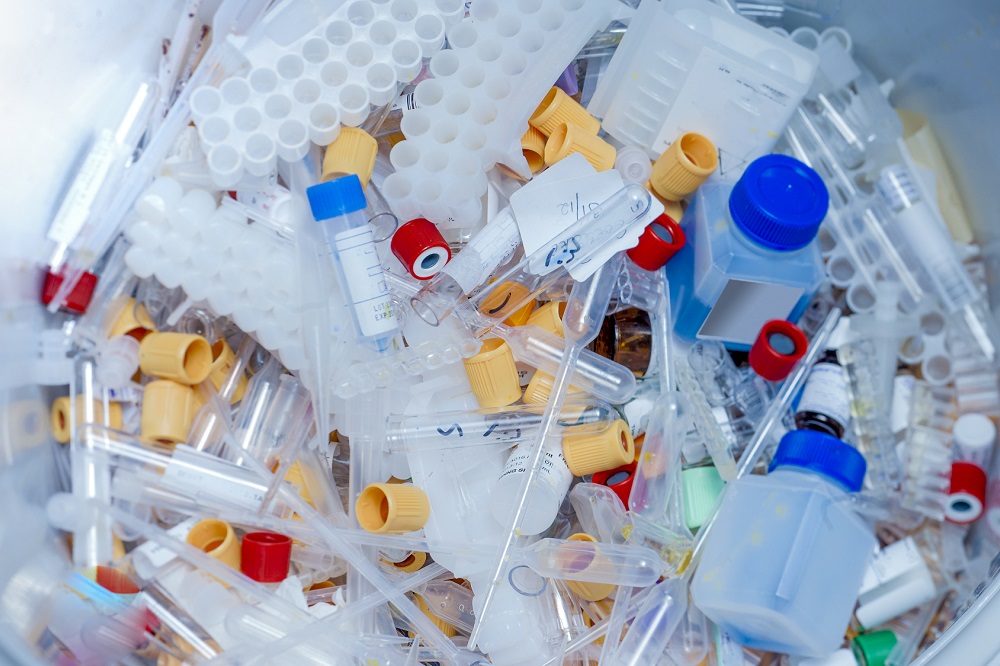Tips for a greener lab

“Think before you throw” is one easy way to care for the planet.
In light of recent science, it has never seemed more urgent to make cultural adjustments to prevent climate change—and science itself is not exempt from this task. Labs tend to go through large quantities of materials—pipette tips, gel plates, medium, beakers—some of which are shipped in layer upon layer of protective plastic and cardboard. Labs also consume a lot of energy, with equipment such as cryogenic freezers, high-powered ventilators, and specialized machines that run around the clock. As a result, even your most routine experiment may leave behind a hefty environmental footprint.
The good news is that there are simple ways to make research gentler on the environment. Members of Daniel Mucida’s Laboratory of Mucosal Immunology have honed several best practices to reduce waste and save energy, and to foster a lab culture where “green” is the norm.
Below are some of their tips, which should be straightforward to adapt for any bioscience lab. “Most people here at Rockefeller are aware of how critical the environment is, but we don’t always pay attention to the things we can do make our labs more sustainable,” Mucida says. “It’s all about forming new habits. Once that happens, these steps are fairly easy.”
#1 Think before you throw
Although most experiments require clean vessels and reagents, not all need to be done in a sterile environment. This means you can limit your use of disposable plastics by reusing them. Rather than hurling used Falcon tubes into the waste basket, for example, members of Mucida’s lab clean the tubes with soap and water and keep them in a tidy drawer for non-sterile use. The exception is plastics that have had contact with biohazardous substances—those should be cleaned with the appropriate bleach solutions and recycled.
#2 Opt for smart shipping and ordering
The lab has set aside a day each week for ordering supplies, making it easier to consolidate shipping and cut back on unnecessary packaging. With this system, materials are regularly monitored. Open dates are recorded on reagent containers, and lab members submit to their ordering system before supplies run out—a safe way to avoid rush orders and the additional packaging materials that come with them.
The lab also prioritizes vendors who don’t over package their products. For supplies bought internally from the university storeroom, the lab has worked with the purchasing department to incorporate “greener” vendors and products. For instance, Falcon tubes are now available either with or without Styrofoam trays, which aren’t always essential, and most stocked materials are commercially recyclable.
#3 Curb the kilowatts
The lab keeps chemical hoods closed when they aren’t in use. And at the end of every work day, lab members also shut down computers, centrifuges, shakers, and other equipment that doesn’t need to be kept on. Whoever is the last one to leave the lab turns off the lights.
The lab temperature is kept between 77 and 78 degrees Fahrenheit in the summer, and around 72 in the winter. The lab has found these temperatures to be a good compromise between maintaining an ideal environment for experiments, saving energy, and respecting people’s comfort level.
#4 Train newcomers
When new graduate students or post docs join the lab, research specialist Aneta Rogoz goes over the lab’s green protocols with them and shows them where the proper recycling receptacles are located. “No one has to learn as they go,” she says. “From the start, we show new recruits where to dispose of what, when to order supplies, and how to avoid wasting reagents. And most importantly, they know that they can ask questions anytime.”
#5 Be a maintenance mogul
Though many pieces of lab equipment look quite hefty and durable, they may require regular attention in order to run efficiently. For appliances whose service contracts don’t include maintenance visits, it can be useful to set up a schedule shared amongst lab members for regular cleaning and upkeep. Freezers are especially prone to ice buildup and inefficiency: don’t forget to defrost them, vacuum the coils, and wash filters.
Upgrading to more energy-efficient refrigerators and freezers is also an option. Overall, chest freezers use less energy than upright units.
If you have questions or suggestions about sustainability at Rockefeller, email our sustainability committee.


